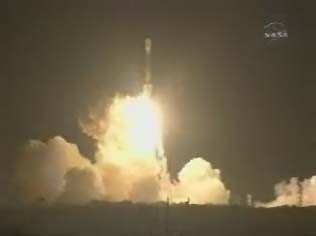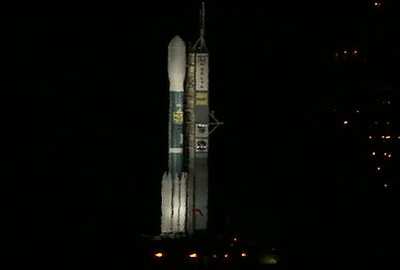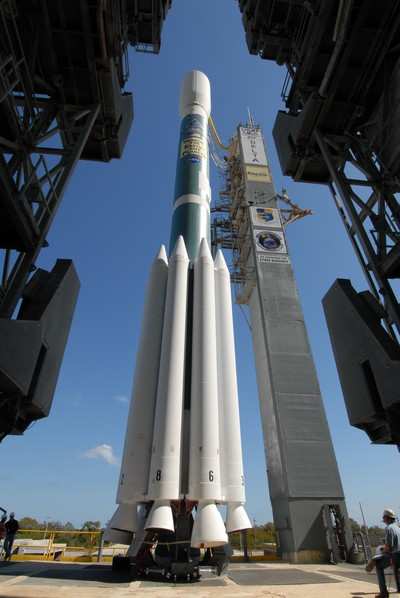Will Study More Than 100,000 Stars Over Next 3.5
Years
 ANN REALTIME UPDATE 03.06.09 2252
EST: Liftoff! Moments ago, NASA's Kepler spacecraft lifted
off the pad from Cape Canaveral Air Force Station in Florida,
propelled towards the heavens atop a Delta II launch vehicle.
T-Minus zero came at 1950 Pacific Time.
ANN REALTIME UPDATE 03.06.09 2252
EST: Liftoff! Moments ago, NASA's Kepler spacecraft lifted
off the pad from Cape Canaveral Air Force Station in Florida,
propelled towards the heavens atop a Delta II launch vehicle.
T-Minus zero came at 1950 Pacific Time.
Sixty-two minutes after launch, Kepler is to separate entirely
from its rocket and will be in its final Earth-trailing orbit
around the sun, an orbit similar to that of NASA's Spitzer Space
Telescope.
After a commissioning period lasting about two months, Kepler
will begin its job of staring at more than 100,000 stars for
three-and-one-half years, looking for planets. Its isolated perch
behind Earth will give the telescope an unobstructed view of a
single, very large patch of sky near the Cygnus and Lyra
constellations.
"We will monitor a wide range of stars; from small cool ones,
where planets must circle closely to stay warm, to stars bigger and
hotter than the sun, where planets must stay well clear to avoid
being roasted," said William Borucki, science principal
investigator for the mission at NASA's Ames Research Center at
Moffett Field, CA.
Borucki has been working on the mission for 17 years.
"Everything about the mission is optimized to find Earth-size
planets with the potential for life, to help us answer the question
-- are Earths bountiful or is our planet unique?"
Original Report
0200 EST: NASA's Kepler mission to seek other
Earth-like planets is undergoing final preparations for liftoff
Friday, March 6, from Pad 17-B at Cape Canaveral Air Force Station
in Florida. NASA has two opportunities for launch Friday, from 7:49
to 7:52 pm PST and 8:13 to 8:16 pm PST.

Kepler is designed to find the first Earth-size planets orbiting
stars in habitable zones -- regions where water could pool on the
surface of the planets. Liquid water is believed to be essential
for the formation of life.
"This mission attempts to answer a question that is as old as
time itself -- are other planets like ours out there?" said Ed
Weiler, associate administrator for NASA's Science Mission
Directorate at NASA Headquarters in Washington. "It's not just a
science question -- it's a basic human question."
Kepler will find planets by looking for periodic dips in
starlight. Planets that happen to pass directly in front of their
stars from Earth's point of view cause the stars to dim by almost
imperceptible amounts. Kepler's powerful camera, the largest ever
flown in space, can see the faintest of these "winks."
Ahead of Kepler's launch, NASA provided the following "Fast
Facts" about the upcoming mission:
- Kepler is the world's first mission with the ability to find
true Earth analogs -- planets that orbit stars like our sun in the
"habitable zone." The habitable zone is the region around a star
where the temperature is just right for water -- an essential
ingredient for life as we know it -- to pool on a planet's
surface.
- By the end of Kepler's three-and-one-half-year mission, it will
give us a good idea of how common or rare other Earths are in our
Milky Way galaxy. This will be an important step in answering the
age-old question: Are we alone?
- Kepler detects planets by looking for periodic dips in the
brightness of stars. Some planets pass in front of their stars as
seen from our point of view on Earth; when they do, they cause
their stars to dim slightly, an event Kepler can see.
- Kepler has the largest camera ever launched into space, a
95-megapixel array of charge-coupled devices, or CCDs, like those
in everyday digital cameras.
- Kepler's telescope is so powerful that, from its view up in
space, it could detect one person in a small town turning off a
porch light at night.

"We are very excited to see this magnificent spacecraft come to
life when it reaches space," said James Fanson, Kepler project
manager at NASA's Jet Propulsion Laboratory, Pasadena, CA.
ANN will provide updates on Friday's launch. Stay tuned.
 ANN's Daily Aero-Term (05.01.24): Say Altitude
ANN's Daily Aero-Term (05.01.24): Say Altitude ANN's Daily Aero-Linx (05.01.24)
ANN's Daily Aero-Linx (05.01.24) Classic Aero-TV: Korean War Hero Twice Reborn
Classic Aero-TV: Korean War Hero Twice Reborn Airborne 04.29.24: EAA B-25 Rides, Textron 2024, G700 Deliveries
Airborne 04.29.24: EAA B-25 Rides, Textron 2024, G700 Deliveries Airborne Affordable Flyers 05.02.24: Bobby Bailey, SPRG Report Cards, Skydive!
Airborne Affordable Flyers 05.02.24: Bobby Bailey, SPRG Report Cards, Skydive!





